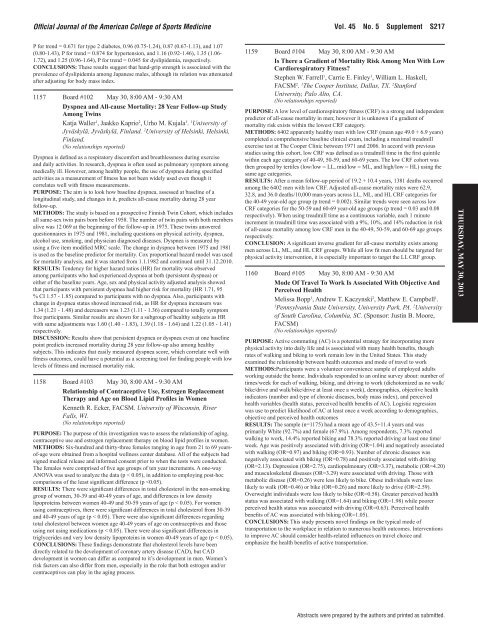Thursday-Abstracts
Thursday-Abstracts
Thursday-Abstracts
Create successful ePaper yourself
Turn your PDF publications into a flip-book with our unique Google optimized e-Paper software.
Official Journal of the American College of Sports Medicine<br />
P for trend = 0.671 for type 2 diabetes, 0.96 (0.75-1.24), 0.87 (0.67-1.13), and 1.07<br />
(0.80-1.43), P for trend = 0.874 for hypertension, and 1.16 (0.92-1.46), 1.35 (1.06-<br />
1.72), and 1.25 (0.96-1.64), P for trend = 0.045 for dyslipidemia, respectively.<br />
CONCLusIONs: These results suggest that hand-grip strength is associated with the<br />
prevalence of dyslipidemia among Japanese males, although its relation was attenuated<br />
after adjusting for body mass index.<br />
1157 Board #102 May 30, 8:00 AM - 9:30 AM<br />
dyspnea and all-cause Mortality: 28 year Follow-up study<br />
among Twins<br />
Katja Waller1 , Jaakko Kaprio2 , Urho M. Kujala1 . 1University of<br />
Jyväskylä, Jyväskylä, Finland. 2University of Helsinki, Helsinki,<br />
Finland.<br />
(No relationships reported)<br />
Dyspnea is defined as a respiratory discomfort and breathlessness during exercise<br />
and daily activities. In research, dyspnea is often used as pulmonary symptom among<br />
medically ill. However, among healthy people, the use of dyspnea during specified<br />
activities as a measurement of fitness has not been widely used even though it<br />
correlates well with fitness measurements.<br />
PurPOsE: The aim is to look how baseline dyspnea, assessed at baseline of a<br />
longitudinal study, and changes in it, predicts all-cause mortality during 28 year<br />
follow-up.<br />
METhOds: The study is based on a prospective Finnish Twin Cohort, which includes<br />
all same-sex twin pairs born before 1958. The number of twin pairs with both members<br />
alive was 12 069 at the beginning of the follow-up in 1975. These twins answered<br />
questionnaires in 1975 and 1981, including questions on physical activity, dyspnea,<br />
alcohol use, smoking, and physician diagnosed diseases. Dyspnea is measured by<br />
using a five item modified MRC scale. The change in dyspnea between 1975 and 1981<br />
is used as the baseline predictor for mortality. Cox proportional hazard model was used<br />
for mortality analysis, and it was started from 1.1.1982 and continued until 31.12.2010.<br />
rEsuLTs: Tendency for higher hazard ratios (HR) for mortality was observed<br />
among participants who had experienced dyspnea at both (persistent dyspnea) or<br />
either of the baseline years. Age, sex and physical activity adjusted analysis showed<br />
that participants with persistent dyspnea had higher risk for mortality (HR 1.71, 95<br />
% CI 1.57 - 1.85) compared to participants with no dyspnea. Also, participants with<br />
change in dyspnea status showed increased risk, as HR for dyspnea increasers was<br />
1.34 (1.21 - 1.48) and decreasers was 1.23 (1.11 - 1.36) compared to totally symptom<br />
free participants. Similar results are shown for a subgroup of healthy subjects as HR<br />
with same adjustments was 1.60 (1.40 - 1.83), 1.39 (1.18 - 1.64) and 1.22 (1.05 - 1.41)<br />
respectively.<br />
dIsCussION: Results show that persistent dyspnea or dyspnea even at one baseline<br />
point predicts increased mortality during 28 year follow-up also among healthy<br />
subjects. This indicates that easily measured dyspnea score, which correlate well with<br />
fitness outcomes, could have a potential as a screening tool for finding people with low<br />
levels of fitness and increased mortality risk.<br />
1158 Board #103 May 30, 8:00 AM - 9:30 AM<br />
relationship of Contraceptive use, Estrogen replacement<br />
Therapy and age on Blood Lipid Profiles in Women<br />
Kenneth R. Ecker, FACSM. University of Wisconsin, River<br />
Falls, WI.<br />
(No relationships reported)<br />
PurPOsE: The purpose of this investigation was to assess the relationship of aging,<br />
contraceptive use and estrogen replacement therapy on blood lipid profiles in women.<br />
METhOds: Six-hundred and thirty-three females ranging in age from 21 to 69 yearsof-age<br />
were obtained from a hospital wellness center database. All of the subjects had<br />
signed medical release and informed consent prior to when the tests were conducted.<br />
The females were comprised of five age groups of ten year increments. A one-way<br />
ANOVA was used to analyze the data (p < 0.05), in addition to employing post-hoc<br />
comparisons of the least significant difference (p


